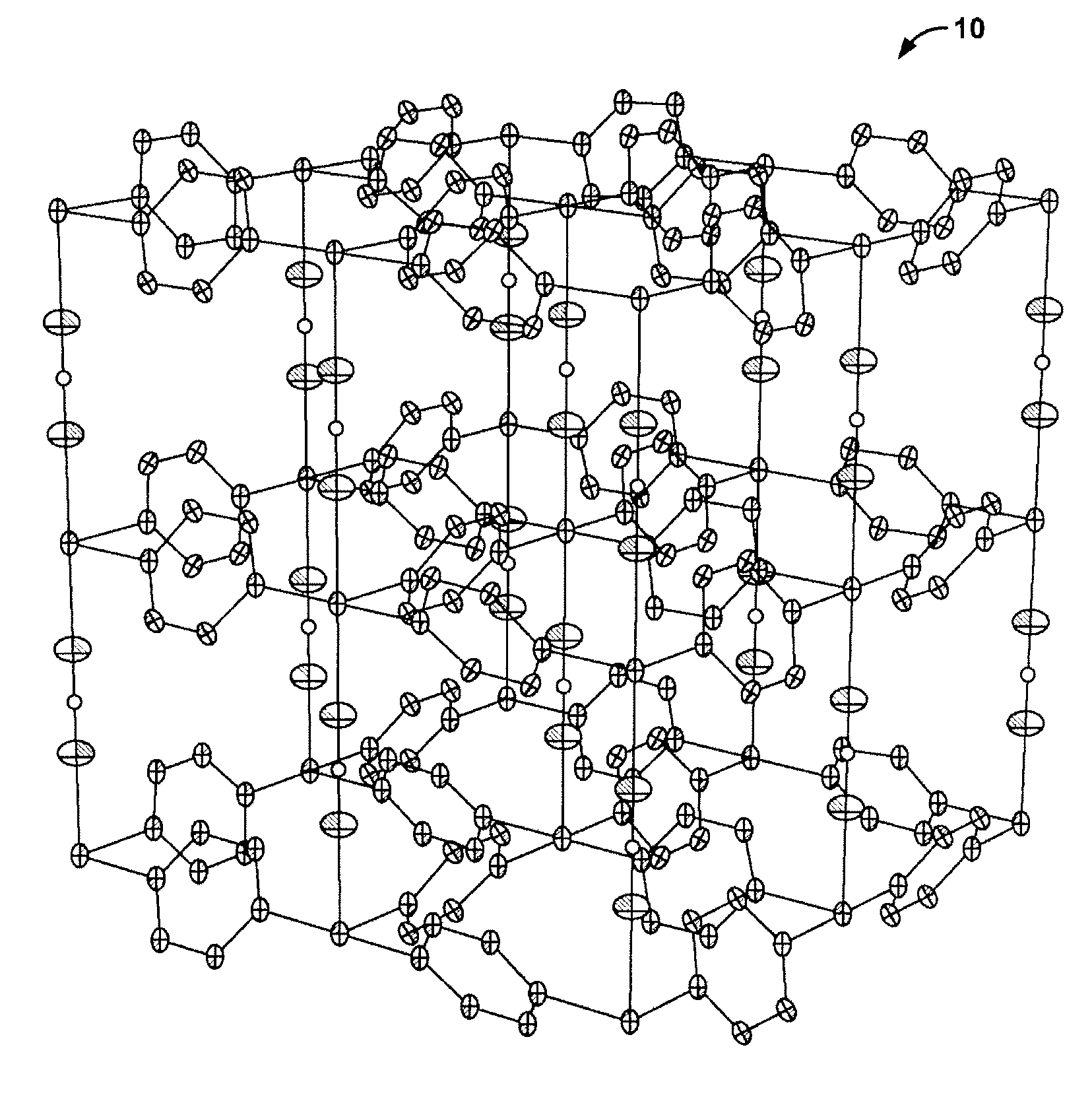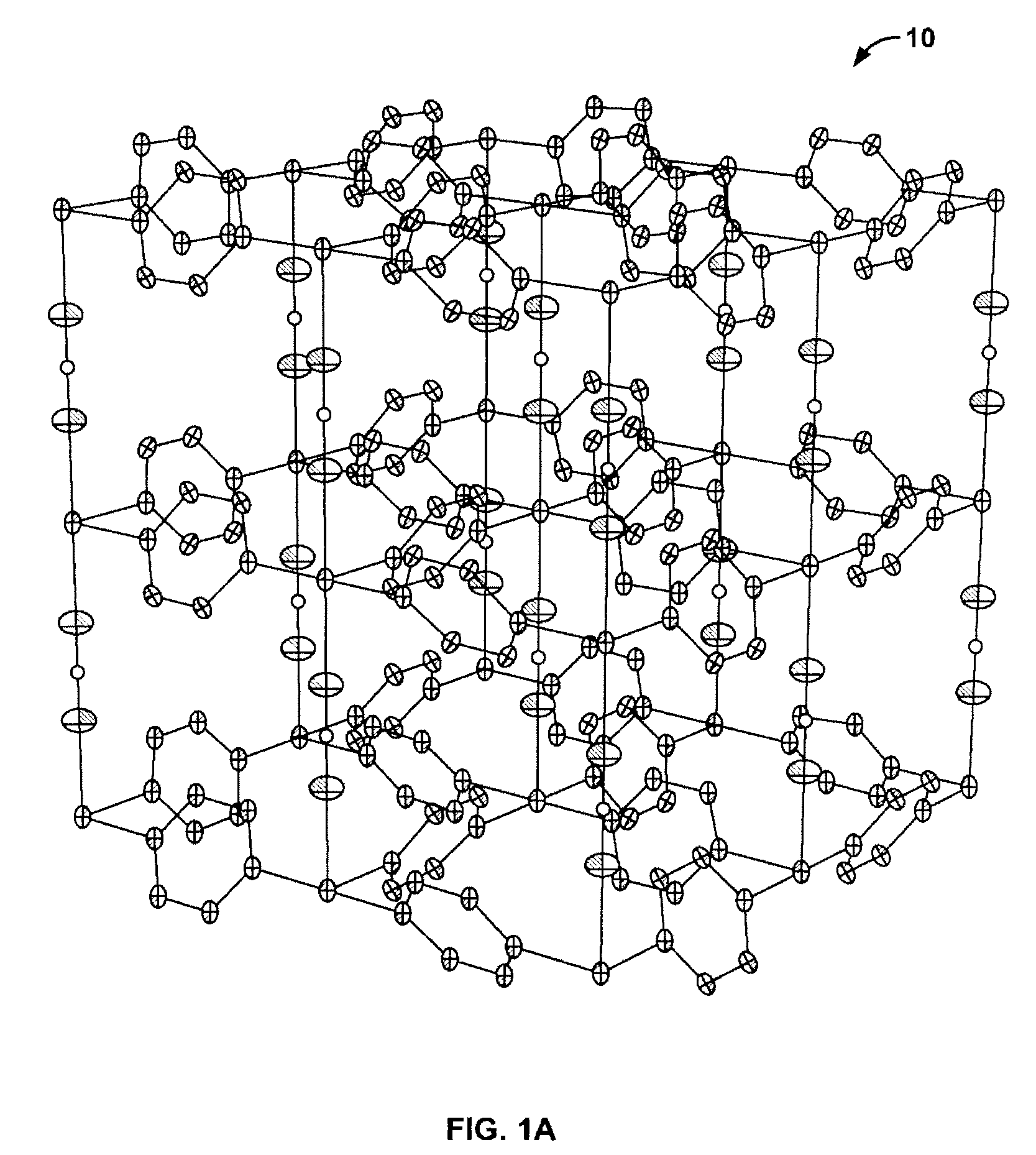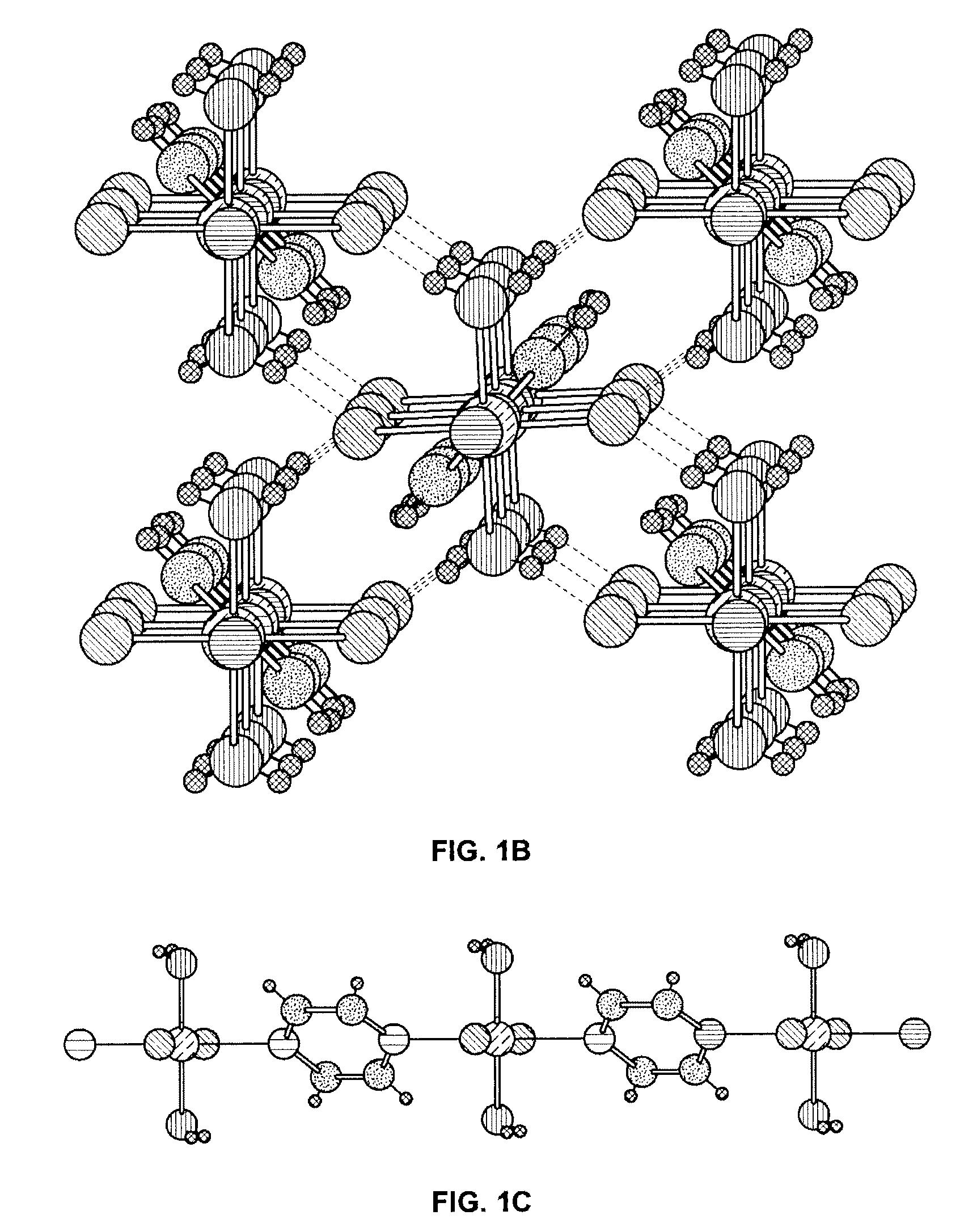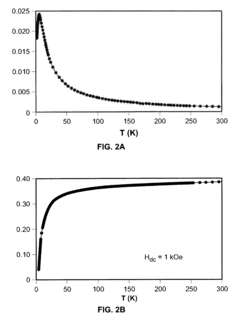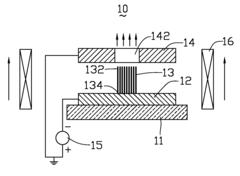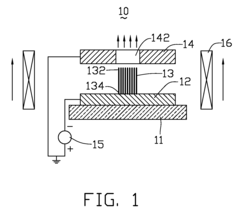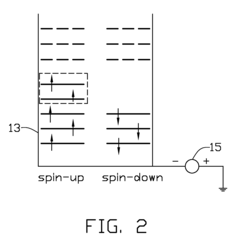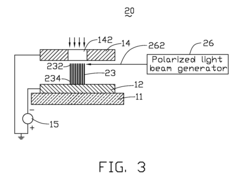Exploring Spintronic Devices' Potential in Quantum Computing
OCT 21, 202510 MIN READ
Generate Your Research Report Instantly with AI Agent
Patsnap Eureka helps you evaluate technical feasibility & market potential.
Spintronics in Quantum Computing: Background and Objectives
Spintronics represents a revolutionary approach to electronics that exploits the intrinsic spin of electrons in addition to their charge. The field has evolved significantly since the discovery of giant magnetoresistance (GMR) in the late 1980s, which earned Albert Fert and Peter Grünberg the 2007 Nobel Prize in Physics. This breakthrough laid the foundation for modern data storage technologies and opened new avenues for quantum information processing.
The convergence of spintronics and quantum computing presents a promising frontier in computational technology. Traditional quantum computing approaches face significant challenges related to qubit coherence, scalability, and error correction. Spintronic devices offer potential solutions to these limitations by leveraging quantum spin states as information carriers, potentially enabling more stable and manipulable qubits.
Recent technological advancements have accelerated spintronic development, including improved materials for spin injection, detection, and manipulation. Particularly noteworthy is progress in antiferromagnetic spintronics, topological insulators, and two-dimensional magnetic materials, which demonstrate unique spin-dependent properties applicable to quantum computing architectures.
The primary technical objectives in this field include developing room-temperature quantum spintronic devices, increasing spin coherence times, and creating scalable architectures for quantum information processing. These goals address the fundamental requirements for practical quantum computing: maintaining quantum states long enough to perform meaningful computations while enabling complex operations across multiple qubits.
Current research trends indicate growing interest in hybrid systems that combine spintronic elements with superconducting circuits or photonic components. These approaches aim to harness the advantages of multiple quantum technologies, potentially overcoming the limitations inherent to any single platform.
The evolution of spintronic quantum computing is closely tied to advances in nanofabrication techniques, which enable precise control over material properties at atomic scales. As fabrication capabilities improve, increasingly sophisticated spintronic quantum devices become feasible, expanding the potential application space.
Looking forward, spintronic quantum computing technology is expected to progress through several distinct phases: from fundamental proof-of-concept demonstrations to small-scale functional quantum processors, and eventually toward fault-tolerant quantum computing systems. Each stage presents unique technical challenges and opportunities for innovation in materials science, device engineering, and quantum control protocols.
The ultimate goal remains developing quantum computing systems that can outperform classical computers for specific high-value problems in fields such as cryptography, materials science, and pharmaceutical development. Spintronic approaches offer a promising path toward this objective, with potential advantages in scalability and integration with existing semiconductor technologies.
The convergence of spintronics and quantum computing presents a promising frontier in computational technology. Traditional quantum computing approaches face significant challenges related to qubit coherence, scalability, and error correction. Spintronic devices offer potential solutions to these limitations by leveraging quantum spin states as information carriers, potentially enabling more stable and manipulable qubits.
Recent technological advancements have accelerated spintronic development, including improved materials for spin injection, detection, and manipulation. Particularly noteworthy is progress in antiferromagnetic spintronics, topological insulators, and two-dimensional magnetic materials, which demonstrate unique spin-dependent properties applicable to quantum computing architectures.
The primary technical objectives in this field include developing room-temperature quantum spintronic devices, increasing spin coherence times, and creating scalable architectures for quantum information processing. These goals address the fundamental requirements for practical quantum computing: maintaining quantum states long enough to perform meaningful computations while enabling complex operations across multiple qubits.
Current research trends indicate growing interest in hybrid systems that combine spintronic elements with superconducting circuits or photonic components. These approaches aim to harness the advantages of multiple quantum technologies, potentially overcoming the limitations inherent to any single platform.
The evolution of spintronic quantum computing is closely tied to advances in nanofabrication techniques, which enable precise control over material properties at atomic scales. As fabrication capabilities improve, increasingly sophisticated spintronic quantum devices become feasible, expanding the potential application space.
Looking forward, spintronic quantum computing technology is expected to progress through several distinct phases: from fundamental proof-of-concept demonstrations to small-scale functional quantum processors, and eventually toward fault-tolerant quantum computing systems. Each stage presents unique technical challenges and opportunities for innovation in materials science, device engineering, and quantum control protocols.
The ultimate goal remains developing quantum computing systems that can outperform classical computers for specific high-value problems in fields such as cryptography, materials science, and pharmaceutical development. Spintronic approaches offer a promising path toward this objective, with potential advantages in scalability and integration with existing semiconductor technologies.
Market Analysis for Spintronic Quantum Technologies
The global market for spintronic quantum technologies is experiencing significant growth, driven by increasing investments in quantum computing research and the potential advantages that spintronics offers over traditional electronic systems. Current market estimates value the quantum computing sector at approximately $500 million, with spintronic applications representing a growing segment within this space. Industry analysts project this market to expand at a compound annual growth rate of 25-30% over the next five years, potentially reaching $2 billion by 2028.
Demand for spintronic quantum technologies stems primarily from three sectors: government research institutions, academic laboratories, and technology corporations. Government agencies, particularly in the United States, China, and the European Union, have allocated substantial funding for quantum computing research, with spintronics receiving increased attention due to its potential for room-temperature quantum operations. The U.S. National Quantum Initiative alone has dedicated over $1.2 billion to quantum information science, with a portion directed toward spintronic research.
In the private sector, major technology companies including IBM, Intel, Microsoft, and Google have established dedicated quantum computing divisions, with several exploring spintronic approaches alongside other quantum technologies. Venture capital investment in quantum computing startups working with spintronic technologies has tripled since 2018, reflecting growing confidence in commercial applications.
Market segmentation reveals distinct application areas driving demand. Cryptography and security applications represent the largest current market segment, accounting for approximately 35% of spintronic quantum technology investments. This is followed by materials science applications (25%), pharmaceutical research (20%), and financial modeling (15%). The remaining market share is distributed across various emerging applications including logistics optimization and artificial intelligence.
Geographically, North America leads in market share (45%), followed by Europe (30%) and Asia-Pacific (20%). However, China's investments in quantum technologies are growing at the fastest rate, potentially shifting this distribution in the coming years. Japan and South Korea have also announced national initiatives specifically targeting spintronic quantum technologies.
Customer adoption patterns indicate that early adopters are primarily research institutions and large technology corporations with substantial R&D budgets. The technology remains in pre-commercial stages for most applications, with a technology readiness level ranging from 3 to 5 depending on the specific implementation. Market analysts predict that the first commercially viable spintronic quantum computing solutions will emerge within 3-5 years, initially serving specialized niche applications before broader market penetration becomes possible.
Demand for spintronic quantum technologies stems primarily from three sectors: government research institutions, academic laboratories, and technology corporations. Government agencies, particularly in the United States, China, and the European Union, have allocated substantial funding for quantum computing research, with spintronics receiving increased attention due to its potential for room-temperature quantum operations. The U.S. National Quantum Initiative alone has dedicated over $1.2 billion to quantum information science, with a portion directed toward spintronic research.
In the private sector, major technology companies including IBM, Intel, Microsoft, and Google have established dedicated quantum computing divisions, with several exploring spintronic approaches alongside other quantum technologies. Venture capital investment in quantum computing startups working with spintronic technologies has tripled since 2018, reflecting growing confidence in commercial applications.
Market segmentation reveals distinct application areas driving demand. Cryptography and security applications represent the largest current market segment, accounting for approximately 35% of spintronic quantum technology investments. This is followed by materials science applications (25%), pharmaceutical research (20%), and financial modeling (15%). The remaining market share is distributed across various emerging applications including logistics optimization and artificial intelligence.
Geographically, North America leads in market share (45%), followed by Europe (30%) and Asia-Pacific (20%). However, China's investments in quantum technologies are growing at the fastest rate, potentially shifting this distribution in the coming years. Japan and South Korea have also announced national initiatives specifically targeting spintronic quantum technologies.
Customer adoption patterns indicate that early adopters are primarily research institutions and large technology corporations with substantial R&D budgets. The technology remains in pre-commercial stages for most applications, with a technology readiness level ranging from 3 to 5 depending on the specific implementation. Market analysts predict that the first commercially viable spintronic quantum computing solutions will emerge within 3-5 years, initially serving specialized niche applications before broader market penetration becomes possible.
Current Spintronic Implementations and Technical Barriers
Current spintronic implementations in quantum computing represent a diverse landscape of experimental and commercial applications. Magnetic tunnel junctions (MTJs) stand as the most mature spintronic technology, forming the foundation for commercial magnetic random-access memory (MRAM) products. These devices leverage the tunnel magnetoresistance effect to store quantum information in the relative orientation of magnetic layers. Companies like Samsung, Intel, and TSMC have already integrated MRAM into their semiconductor processes, demonstrating the industrial viability of spintronic technologies.
Spin-transfer torque (STT) devices represent another significant implementation, where spin-polarized currents manipulate magnetic states. These devices offer advantages in energy efficiency and switching speed compared to conventional electronic components. Recent experimental demonstrations have achieved switching times in the sub-nanosecond range, making them potentially suitable for quantum gate operations.
Spin-orbit torque (SOT) devices have emerged as a promising alternative to STT, utilizing the spin-orbit coupling effect to manipulate magnetic moments. Research groups at MIT and the University of Tokyo have demonstrated SOT-based quantum bit operations with improved coherence times compared to earlier spintronic implementations.
Despite these advances, significant technical barriers impede the full integration of spintronics into quantum computing architectures. The foremost challenge remains quantum decoherence - the loss of quantum information due to environmental interactions. While spintronic qubits offer longer coherence times than some competing technologies, they still fall short of the requirements for complex quantum algorithms. Current coherence times typically range from microseconds to milliseconds, whereas practical quantum computing may require seconds or longer.
Material interface issues present another substantial barrier. The performance of spintronic devices depends critically on the quality of interfaces between different materials, where spin information can be lost or degraded. Atomic-level precision in fabrication remains challenging to achieve consistently at scale.
Thermal stability poses a significant challenge, particularly for room-temperature quantum operations. Many spintronic implementations require cryogenic cooling to maintain quantum states, limiting practical applications. Recent room-temperature demonstrations have shown promise but with reduced coherence times and fidelity.
Scalability represents perhaps the most formidable barrier. While individual spintronic qubits have been demonstrated, creating and controlling large arrays of interconnected qubits introduces exponential complexity. Current fabrication techniques struggle to maintain the necessary uniformity across large arrays, resulting in variable qubit performance that undermines quantum algorithm execution.
Spin-transfer torque (STT) devices represent another significant implementation, where spin-polarized currents manipulate magnetic states. These devices offer advantages in energy efficiency and switching speed compared to conventional electronic components. Recent experimental demonstrations have achieved switching times in the sub-nanosecond range, making them potentially suitable for quantum gate operations.
Spin-orbit torque (SOT) devices have emerged as a promising alternative to STT, utilizing the spin-orbit coupling effect to manipulate magnetic moments. Research groups at MIT and the University of Tokyo have demonstrated SOT-based quantum bit operations with improved coherence times compared to earlier spintronic implementations.
Despite these advances, significant technical barriers impede the full integration of spintronics into quantum computing architectures. The foremost challenge remains quantum decoherence - the loss of quantum information due to environmental interactions. While spintronic qubits offer longer coherence times than some competing technologies, they still fall short of the requirements for complex quantum algorithms. Current coherence times typically range from microseconds to milliseconds, whereas practical quantum computing may require seconds or longer.
Material interface issues present another substantial barrier. The performance of spintronic devices depends critically on the quality of interfaces between different materials, where spin information can be lost or degraded. Atomic-level precision in fabrication remains challenging to achieve consistently at scale.
Thermal stability poses a significant challenge, particularly for room-temperature quantum operations. Many spintronic implementations require cryogenic cooling to maintain quantum states, limiting practical applications. Recent room-temperature demonstrations have shown promise but with reduced coherence times and fidelity.
Scalability represents perhaps the most formidable barrier. While individual spintronic qubits have been demonstrated, creating and controlling large arrays of interconnected qubits introduces exponential complexity. Current fabrication techniques struggle to maintain the necessary uniformity across large arrays, resulting in variable qubit performance that undermines quantum algorithm execution.
State-of-the-Art Spintronic Quantum Computing Solutions
01 Magnetic tunnel junction (MTJ) structures for spintronic devices
Magnetic tunnel junction structures are fundamental components in spintronic devices, consisting of two ferromagnetic layers separated by an insulating barrier. These structures utilize electron spin for data storage and processing, offering advantages in non-volatility and energy efficiency. Advanced MTJ designs incorporate specialized materials and layer configurations to enhance performance metrics such as tunnel magnetoresistance ratio, thermal stability, and switching efficiency.- Magnetic Tunnel Junction (MTJ) Structures: Magnetic Tunnel Junction (MTJ) structures are fundamental components in spintronic devices, consisting of two ferromagnetic layers separated by an insulating barrier. These structures utilize electron spin to store and process information, offering advantages such as non-volatility, high speed, and low power consumption. Advanced MTJ designs incorporate materials like CoFeB and MgO barriers to enhance tunnel magnetoresistance ratio and thermal stability, which are critical for memory applications and logic operations.
- Spin-Orbit Torque (SOT) Based Devices: Spin-Orbit Torque (SOT) technology represents an evolution in spintronic device design, utilizing the interaction between electron spin and orbital motion to manipulate magnetic states. SOT-based devices offer faster switching speeds and reduced energy consumption compared to conventional spin-transfer torque mechanisms. These devices typically incorporate heavy metal layers adjacent to magnetic materials to generate efficient spin currents, enabling applications in high-performance memory, logic circuits, and neuromorphic computing systems.
- Integration of Spintronic Devices with Semiconductor Technology: The integration of spintronic devices with conventional semiconductor technology enables hybrid systems that combine the advantages of both approaches. This integration involves developing compatible fabrication processes, addressing interface challenges between magnetic and semiconductor materials, and designing circuits that effectively utilize spin-based information processing. Such hybrid systems can serve as building blocks for energy-efficient computing architectures, including non-volatile processors, reconfigurable logic, and in-memory computing solutions.
- Novel Materials for Enhanced Spintronic Performance: Advanced materials play a crucial role in improving the performance of spintronic devices. These include topological insulators, Heusler alloys, 2D materials, and antiferromagnetic compounds that exhibit unique spin-dependent electronic properties. The development of these materials focuses on achieving high spin polarization, long spin coherence times, and efficient spin-charge conversion. Material engineering approaches such as interface modification, doping, and strain control are employed to optimize spin transport properties for next-generation spintronic applications.
- Spintronic Sensors and Energy Harvesting Applications: Beyond computing applications, spintronic devices are being developed for sensing and energy harvesting purposes. Spin-based sensors offer high sensitivity for detecting magnetic fields, enabling applications in biomedical imaging, automotive systems, and industrial monitoring. Additionally, spintronic principles are being applied to harvest energy from thermal gradients and mechanical vibrations through spin-dependent thermoelectric and piezoelectric effects, contributing to self-powered electronic systems and IoT devices.
02 Spin-orbit torque (SOT) based memory and logic devices
Spin-orbit torque technology enables efficient manipulation of magnetic moments in spintronic devices without requiring large current densities. SOT-based devices utilize materials with strong spin-orbit coupling to convert charge currents into spin currents, facilitating magnetization switching. These devices offer advantages including faster switching speeds, lower power consumption, and enhanced endurance compared to conventional magnetic memory technologies, making them promising candidates for next-generation computing architectures.Expand Specific Solutions03 Integration of spintronic devices with semiconductor technology
The integration of spintronic devices with conventional semiconductor technology enables hybrid systems that combine the advantages of both platforms. This approach involves developing compatible fabrication processes, addressing interface challenges, and designing circuit architectures that effectively utilize spin-based components. Successful integration strategies include embedding spintronic elements within CMOS processes, developing specialized interconnects, and creating interface circuits that translate between spin and charge domains.Expand Specific Solutions04 Novel materials for enhanced spintronic performance
Advanced materials play a crucial role in improving spintronic device performance. Research focuses on developing materials with high spin polarization, strong spin-orbit coupling, and appropriate magnetic properties. These include topological insulators, Weyl semimetals, 2D materials, and engineered heterostructures. Novel material systems enable functionalities such as improved spin injection efficiency, longer spin coherence times, and more efficient spin-charge interconversion, leading to devices with superior performance characteristics.Expand Specific Solutions05 Spintronic sensors and detection systems
Spintronic sensors leverage spin-dependent transport phenomena to detect magnetic fields, currents, or other physical quantities with high sensitivity. These sensors utilize effects such as giant magnetoresistance (GMR), tunnel magnetoresistance (TMR), or anomalous Hall effect to convert magnetic signals into electrical outputs. Applications include biomedical sensing, industrial monitoring, automotive systems, and scientific instrumentation, where they offer advantages in sensitivity, size, power consumption, and compatibility with semiconductor readout electronics.Expand Specific Solutions
Leading Organizations in Spintronic Quantum Research
The spintronic quantum computing landscape is currently in an early development stage, characterized by significant research momentum but limited commercial deployment. The global quantum computing market, valued at approximately $500 million, is projected to grow exponentially as spintronic quantum technologies mature. Leading research institutions like Tsinghua University, Peking University, and the University of California are advancing fundamental science, while commercial players demonstrate varying technological readiness. D-Wave Systems has achieved early commercialization with quantum annealing systems, while Intel and Origin Quantum are developing gate-model architectures incorporating spintronic elements. Quantum Motion Technologies represents specialized spintronic approaches. The field exhibits a collaborative ecosystem between academic institutions and industry partners, with significant government investment accelerating development across North America, Europe, and Asia.
D-Wave Systems, Inc.
Technical Solution: D-Wave has pioneered the development of quantum annealing processors that incorporate spintronic elements for quantum computing. Their approach utilizes superconducting flux qubits with magnetic coupling mechanisms that leverage spin-based interactions. The company's latest Advantage™ system employs over 5,000 qubits in a Pegasus topology that enables complex quantum operations through spin-spin interactions. D-Wave has integrated spintronic components to enhance qubit coherence times and reduce susceptibility to environmental noise. Their quantum annealing architecture specifically exploits magnetic spin states to represent quantum bits, allowing for efficient implementation of optimization algorithms. Recent advancements include improved control of spin dynamics and coupling strengths between qubits, enabling more precise quantum operations.
Strengths: Industry-leading expertise in quantum annealing with practical applications in optimization problems; established commercial quantum computing platform with real-world implementations. Weaknesses: Limited to quantum annealing rather than universal quantum computing; spintronic integration is still evolving and faces scalability challenges compared to other quantum technologies.
Intel Corp.
Technical Solution: Intel has developed a comprehensive spintronic quantum computing approach called "Horse Ridge," a cryogenic control chip that facilitates the control of multiple qubits. Their technology integrates spin qubits in silicon, leveraging their semiconductor manufacturing expertise to create scalable quantum systems. Intel's spin qubit technology operates by manipulating the spin states of electrons in silicon quantum dots, achieving longer coherence times than many competing approaches. The company has demonstrated the ability to fabricate these spin qubits using their 300mm manufacturing technology, potentially enabling the integration of millions of qubits on a single chip. Intel's research focuses on addressing the interconnect bottleneck between quantum processors and their control electronics through innovative spintronic interfaces that maintain quantum coherence while enabling efficient control signals transmission.
Strengths: Leverages existing semiconductor manufacturing infrastructure for potential large-scale production; silicon-based spin qubits offer longer coherence times and potential room temperature operation. Weaknesses: Still in research phase with fewer demonstrated qubits than superconducting approaches; interconnect challenges between classical and quantum components remain significant.
Key Patents and Research Breakthroughs in Quantum Spintronics
Magnetic coupling through strong hydrogen bonds
PatentInactiveUS20090048414A1
Innovation
- The development of magnetic coordination polymers with strong hydrogen bonds, specifically using bifluoride ions and pyrazine ligands, enables controlled growth of materials that mediate magnetic coupling and can manipulate electron spin states, allowing for the creation of robust and defect-free spintronic components.
Spin-polarized electron source and spin-polarized scanning tunneling microscope
PatentActiveUS7459682B2
Innovation
- A spin-polarized electron source utilizing one-dimensional nanostructures of group III-V compound semiconductors with local polarized gap states, where a magnetic field induction or circularly polarized light beam excitation enables efficient spin-polarized electron emission, allowing for continuous and efficient emission of spin-polarized electron currents.
Materials Science Advancements for Spintronic Quantum Systems
The advancement of materials science has been pivotal in unlocking the potential of spintronic devices for quantum computing applications. Recent breakthroughs in novel materials with enhanced spin properties have significantly accelerated progress in this field. Particularly noteworthy are developments in two-dimensional materials such as graphene and transition metal dichalcogenides (TMDs), which exhibit exceptional spin coherence times and controllability.
Magnetic topological insulators represent another frontier, offering robust quantum states that are protected against environmental decoherence. These materials feature unique surface states where electron spin and momentum are locked, providing an ideal platform for quantum information processing with inherent error correction capabilities.
Researchers have also made substantial progress with dilute magnetic semiconductors, which integrate magnetic properties into traditional semiconductor frameworks. This compatibility with existing fabrication technologies presents a significant advantage for scaling up quantum computing systems based on spintronic principles.
Heterostructure engineering has emerged as a critical approach, where precisely layered materials create quantum wells and barriers that enhance spin manipulation and detection. The interface phenomena between different materials often yield unexpected quantum effects that can be harnessed for computing applications.
Superconductor-ferromagnet junctions have demonstrated particular promise for creating and controlling quantum entanglement, a fundamental requirement for quantum computing. These hybrid structures leverage the complementary properties of both material types to achieve functionalities impossible with either material alone.
Advanced fabrication techniques, including molecular beam epitaxy and atomic layer deposition, have reached unprecedented precision levels, enabling the creation of materials with atomic-scale control. This precision is essential for maintaining quantum coherence in spintronic devices, where even minor imperfections can disrupt quantum states.
The development of room-temperature quantum materials represents perhaps the most significant materials science challenge. Current spintronic quantum systems typically require cryogenic temperatures to operate effectively, limiting practical applications. However, recent research into nitrogen-vacancy centers in diamond and certain metal-organic frameworks shows promise for room-temperature quantum operations.
These materials science advancements collectively address the fundamental challenges of spin lifetime, initialization fidelity, and readout accuracy that have historically limited spintronic quantum computing. As fabrication techniques continue to evolve alongside theoretical understanding, we can anticipate further breakthroughs that will bring practical spintronic quantum computers closer to reality.
Magnetic topological insulators represent another frontier, offering robust quantum states that are protected against environmental decoherence. These materials feature unique surface states where electron spin and momentum are locked, providing an ideal platform for quantum information processing with inherent error correction capabilities.
Researchers have also made substantial progress with dilute magnetic semiconductors, which integrate magnetic properties into traditional semiconductor frameworks. This compatibility with existing fabrication technologies presents a significant advantage for scaling up quantum computing systems based on spintronic principles.
Heterostructure engineering has emerged as a critical approach, where precisely layered materials create quantum wells and barriers that enhance spin manipulation and detection. The interface phenomena between different materials often yield unexpected quantum effects that can be harnessed for computing applications.
Superconductor-ferromagnet junctions have demonstrated particular promise for creating and controlling quantum entanglement, a fundamental requirement for quantum computing. These hybrid structures leverage the complementary properties of both material types to achieve functionalities impossible with either material alone.
Advanced fabrication techniques, including molecular beam epitaxy and atomic layer deposition, have reached unprecedented precision levels, enabling the creation of materials with atomic-scale control. This precision is essential for maintaining quantum coherence in spintronic devices, where even minor imperfections can disrupt quantum states.
The development of room-temperature quantum materials represents perhaps the most significant materials science challenge. Current spintronic quantum systems typically require cryogenic temperatures to operate effectively, limiting practical applications. However, recent research into nitrogen-vacancy centers in diamond and certain metal-organic frameworks shows promise for room-temperature quantum operations.
These materials science advancements collectively address the fundamental challenges of spin lifetime, initialization fidelity, and readout accuracy that have historically limited spintronic quantum computing. As fabrication techniques continue to evolve alongside theoretical understanding, we can anticipate further breakthroughs that will bring practical spintronic quantum computers closer to reality.
Quantum Error Correction in Spintronic Architectures
Quantum Error Correction in Spintronic Architectures represents one of the most critical challenges in advancing spintronic-based quantum computing systems. The inherent fragility of quantum states makes error correction an essential component for practical quantum computation. Spintronic architectures offer unique advantages in this domain due to their potential for longer coherence times compared to some other quantum platforms.
Traditional quantum error correction codes, such as surface codes and Steane codes, require significant qubit overhead that poses implementation challenges in current spintronic systems. However, recent advancements in spin-based qubits have demonstrated promising error correction capabilities through the exploitation of the electron spin's natural resistance to certain types of environmental noise.
The development of topological error correction methods specifically tailored for spintronic systems has gained significant traction. These approaches leverage the geometric properties of spin arrangements to create error-resistant logical qubits. Particularly noteworthy is the adaptation of the Kitaev model for spin-lattice structures, which provides inherent protection against local perturbations while maintaining computational functionality.
Dynamical decoupling techniques have proven especially effective in spintronic quantum error correction. By applying precisely timed control pulses, researchers have demonstrated the ability to significantly extend coherence times in spin-based qubits, effectively filtering out environmental noise that would otherwise lead to computational errors. Recent experiments have achieved up to 100-fold improvements in coherence times using optimized pulse sequences.
Hardware-efficient error correction codes represent another promising direction for spintronic quantum computing. These codes require fewer physical qubits to encode logical information, making them particularly suitable for near-term spintronic devices with limited qubit counts. The development of specialized codes that exploit the unique characteristics of spin qubits, such as their natural coupling mechanisms and control parameters, has shown encouraging results in preliminary implementations.
Integration of machine learning algorithms with spintronic error correction protocols has emerged as a cutting-edge approach. These algorithms can adaptively optimize error correction strategies based on real-time feedback from the quantum system, potentially overcoming the limitations of static error correction methods. Early demonstrations have shown improvements in error thresholds by up to 30% compared to conventional techniques.
The path toward fault-tolerant spintronic quantum computing will likely require a multi-layered approach to error correction, combining hardware-level noise suppression with sophisticated software-based error detection and correction algorithms. As spintronic fabrication techniques continue to improve, the feasibility of implementing more complex error correction schemes increases, bringing practical quantum computing applications closer to reality.
Traditional quantum error correction codes, such as surface codes and Steane codes, require significant qubit overhead that poses implementation challenges in current spintronic systems. However, recent advancements in spin-based qubits have demonstrated promising error correction capabilities through the exploitation of the electron spin's natural resistance to certain types of environmental noise.
The development of topological error correction methods specifically tailored for spintronic systems has gained significant traction. These approaches leverage the geometric properties of spin arrangements to create error-resistant logical qubits. Particularly noteworthy is the adaptation of the Kitaev model for spin-lattice structures, which provides inherent protection against local perturbations while maintaining computational functionality.
Dynamical decoupling techniques have proven especially effective in spintronic quantum error correction. By applying precisely timed control pulses, researchers have demonstrated the ability to significantly extend coherence times in spin-based qubits, effectively filtering out environmental noise that would otherwise lead to computational errors. Recent experiments have achieved up to 100-fold improvements in coherence times using optimized pulse sequences.
Hardware-efficient error correction codes represent another promising direction for spintronic quantum computing. These codes require fewer physical qubits to encode logical information, making them particularly suitable for near-term spintronic devices with limited qubit counts. The development of specialized codes that exploit the unique characteristics of spin qubits, such as their natural coupling mechanisms and control parameters, has shown encouraging results in preliminary implementations.
Integration of machine learning algorithms with spintronic error correction protocols has emerged as a cutting-edge approach. These algorithms can adaptively optimize error correction strategies based on real-time feedback from the quantum system, potentially overcoming the limitations of static error correction methods. Early demonstrations have shown improvements in error thresholds by up to 30% compared to conventional techniques.
The path toward fault-tolerant spintronic quantum computing will likely require a multi-layered approach to error correction, combining hardware-level noise suppression with sophisticated software-based error detection and correction algorithms. As spintronic fabrication techniques continue to improve, the feasibility of implementing more complex error correction schemes increases, bringing practical quantum computing applications closer to reality.
Unlock deeper insights with Patsnap Eureka Quick Research — get a full tech report to explore trends and direct your research. Try now!
Generate Your Research Report Instantly with AI Agent
Supercharge your innovation with Patsnap Eureka AI Agent Platform!
